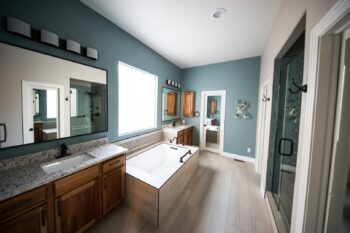
Remodeling Your Bathroom? Here’s What to Do First — and What Not to Forget
Blog contributed by Suzie Wison at www.happierhome.net.
Remodeling your bathroom can either feel like a smart refresh or a spiraling money pit. The difference usually comes down to planning, timing, and knowing what not to DIY. Before you smash a tile or hire a contractor, you need to understand how budgets, materials, and long-term needs intersect. What you install today affects how you live tomorrow — and possibly your resale value. Every choice, from fixtures to finish, sends a message about what matters to you. If you’re about to dive into a bathroom renovation, here’s the clear-eyed breakdown you need.
Budget Smarter, Not Looser
Start by getting honest about your ceiling — then back out about 15%. That buffer will save you later when hidden mold, plumbing quirks, or surprise permits show up. Use tools like smart budget breakdowns to map out where your money’s going: labor, materials, fixtures, permits, and the inevitable “didn’t plan for this” line item. Be specific: lump-sum goals like “under 10k” don’t help when the tile alone eats 30% of that. Price out your dream scenario and your minimum-viable version — then you’ve got room to flex.
Track Everything — and Keep It Searchable
Whether you’re dealing with contractors, submitting drawings to your HOA, or keeping records for resale, digital organization matters. Save copies of everything: quotes, receipts, sketches, permit documents. One simple way to stay organized is to create a PDF of every important file — especially if your city requires uploads for approval. Being able to combine notes, photos, and scans into one clean document streamlines everything. It also reduces the chance you’ll lose a key piece of paper when a contractor ghosts you or a city inspector needs proof. Think of it as a backup for your backup.
Focus on ROI, Not Just Aesthetics
The best bathroom investments aren’t always the prettiest — they’re the ones buyers notice without thinking. Think double vanities, low-flow toilets, and well-placed lighting. According to pros, best upgrades for resale include classic materials like porcelain tile, walk-in showers instead of tubs, and added storage that blends into the architecture. Avoid ultra-specific styles or bold patterns unless you’re planning to stay put for at least five years. ROI drops fast when your remodel becomes someone else’s undo button.
When Professionals Pay for Themselves
Not all remodels need a contractor — but some do, and badly. A good rule of thumb? If a mistake costs more than hiring it out, hire it out. Professionals bring project sequencing, code compliance, warranties, and execution speed you likely can’t match. Knowing how to know when to hire experts can save you thousands and months of aggravation. Plus, licensed contractors are often required for insurance coverage in event of damage or injury during renovations. Think beyond just the install — pros can spot moisture issues, suggest smarter layouts, and prevent aesthetic choices that don’t scale. Don’t just think in cost — think in regret.
Think Sustainably — for Your Budget and the Planet
Eco-conscious design isn’t just trendy — it can be long-lasting, cost-saving, and beautiful. Consider bold eco‑friendly material options like recycled glass tiles, bamboo vanities, or low-flow fixtures that lower water bills. Look for materials labeled GREENGUARD or low-VOC to avoid air quality issues. Reuse what you can — sometimes repainting a cabinet or swapping out handles does more than you expect. Consider resale here too — today’s buyers notice sustainability features, especially if they’re documented. Green can be sleek, not crunchy. Invest in choices that reduce your environmental load without sacrificing form or function.
Design for the Future, Not Just Now
Most people don’t want to think about mobility or aging — until they have to. But the best time to make your bathroom more accessible is before it becomes urgent. Features like no-threshold showers, grab bar reinforcement behind walls, and adjustable-height fixtures don’t have to scream “medical.” In fact, essential aging‑in‑place upgrades can look sleek, even luxurious, when planned right. Use lever handles instead of knobs. Consider anti-slip flooring and wide enough entries for potential future devices. Even if you’re decades away, building with future-you in mind saves stress and cost down the line.
A bathroom remodel isn’t just cosmetic — it’s strategic. The decisions you make ripple across comfort, costs, resale, and how well your space adapts over time. From smart budgeting to aging-in-place features, every choice sends a signal about what matters most.

About Suzie Wilson and Happier Home
Suzie Wilson has been an interior designer for over 20 years. What began as a hobby — often as a favor for friends — gradually evolved into a deep passion for creating calming, welcoming spaces in homes of every size and style.
While Suzie is always focused on making homes visually appealing, her true mission lies in transforming them into serene, stress-free environments that promote a sense of tranquility. She believes that anyone can cultivate a peaceful home atmosphere, even without the help of a professional. Simple changes, like letting in natural sunlight, using soft, muted wall colors, and incorporating lush green houseplants, can have a powerful impact on mood and mental well-being.
Though she continues to work professionally in interior design and is soon to become a published author, Suzie launched Happier Home as a side project to help people everywhere create beautiful, harmonious spaces. All the guidance and services shared on the site are freely offered, reflecting her commitment to making every home a Happier Home.